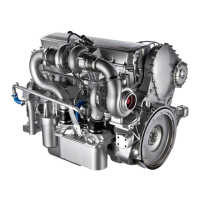SECTION 4 - SCHEDULED MAINTENANCE
5
CURSOR SERIES
Print P4D32C006 E Base - 03/2015
CHECKS TO BE MADE DURING PERIODS
OF USE HOW TO PROCEED
Check the engine lubricant oil level
Figure 1
227776
Only proceed when the engine is not turning and is at low
temperature in order not to run the risk of burns; make sure
the engine is level or in its normal operating position in order
to obtain an accurate oil level reading.
- Use the oil level dipstick (2) to check that the lubricant
oil level is between the ”Min” and ”Max” limits.
- If the level is insufficient, it is necessary to top up the oil
by removing the cap and pouring lubricant oil through
thehole(1).
For the top-up only use lubricant oil that complies
with the international standards as indicated in
Section 1 - General table ”General Characteri-
stics”.
Clean the oil cap before performing the operation
so as to minimize the risk of contaminating the sy-
stem.
- Use the oil level dipstick (2) to check that the lubricant
oil level does not exceed the ”Max” limit on the dipstick.
Make sure that the dipstick is fully inserted and
that the filler plug is tightened fully in the clockwise
direction.
Engine coolant level check (example)
Only proceed when the engine is not turning and is at low
temperature in order not to run the risk of burns.
- Remove the pressurization cap from the expansion tank.
- Visually check that the coolant in the expansion tank is
above the minimum level.
- If necessary, top up the expansion tank with a mixture of
PARAFLU 11 / PA-RAFLU HT, as indicated in Section 1
- General table ”General Characteristics”.
- Top up the expansion tank until the “MAX” limit is rea-
ched; if there is no level indicator on the expansion tank,
make sure that the coolant in the expansion tank is a few
centimetres below the filling hole in order to allow an in-
crease in the coolant volume following a rise in tempe-
rature.
!
When the engine is hot, pressure builds up in the
cooling circuits which may eject hot liquid violen-
tly, resulting in a risk of burns.
Open the filler cap of the coolant tank only if ne-
cessary and only when the engine is cold.
Clean the pressurization cap of the expansion
tank before performing the operation so as to mi-
nimize the risk of contaminating the system.

